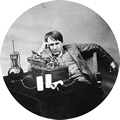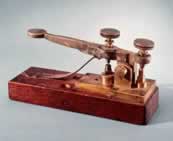 Contested
Currents Contested
Currents
The Race to Electrify America
 Thomas
Alva Edison –
(February 11, 1847 – October 18, 1931) Thomas
Alva Edison –
(February 11, 1847 – October 18, 1931) 
Thomas
Edison worked as a telegraph opperator and became quite familiar
with the design and manufacture of telegraphs. In 1875,
he invented a "multiplex telegraph",
a system that allowed multiple telegraph signals to be sent over
a single wire. He also invented an improved stock
tape ticker, an invention he called the "Universal
Stock Printer".
By selling his patents for these inventions, Edison made enough
money to create the world’s first industrial research lab in Menlo
Park, New Jersey. It was there, in 1877, where
Edison first won internation fame by inventing the phonograph.
His fame and reputation increased even more in 1878,
when Edison improved
the incandescent light bulb.
 To
create an electrical power system for the whole nation, Edison
realized he needed the help of wealthy industralists like JP Morgan
and William Vanderbilt. On
September 4th, 1882, Edison
switched on the world's first DC electrical power distribution system,
providing 110 volts direct current (DC) to lower Manhattan, including
JP Morgan’s house and the offices of the New York Times. To
create an electrical power system for the whole nation, Edison
realized he needed the help of wealthy industralists like JP Morgan
and William Vanderbilt. On
September 4th, 1882, Edison
switched on the world's first DC electrical power distribution system,
providing 110 volts direct current (DC) to lower Manhattan, including
JP Morgan’s house and the offices of the New York Times.
Introduction/Site
Map | Classroom Resources | Bibliography || Cover
Page
|